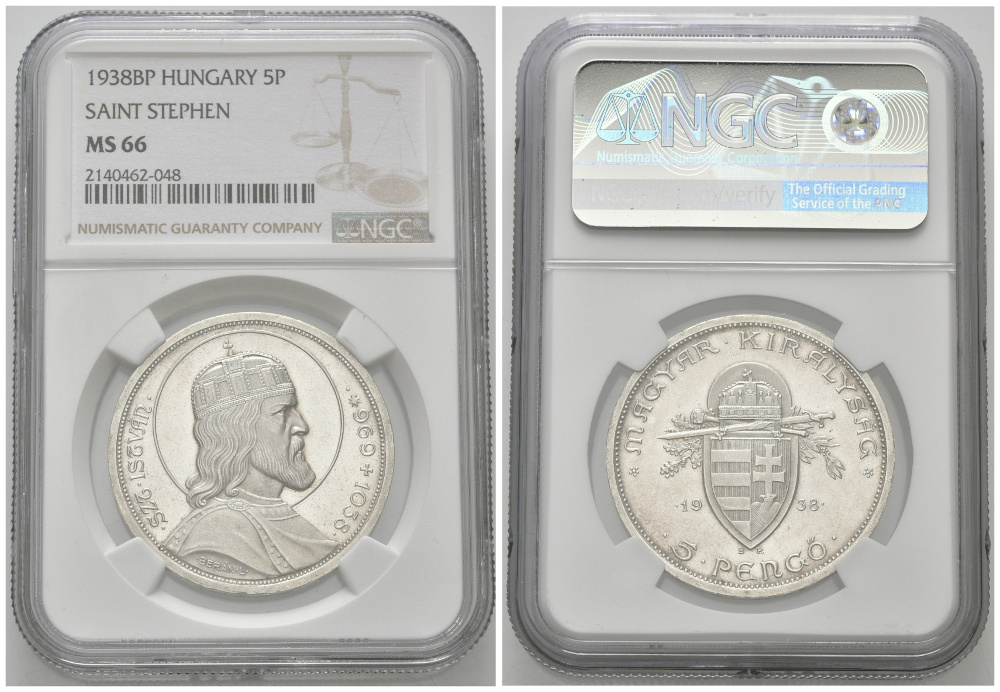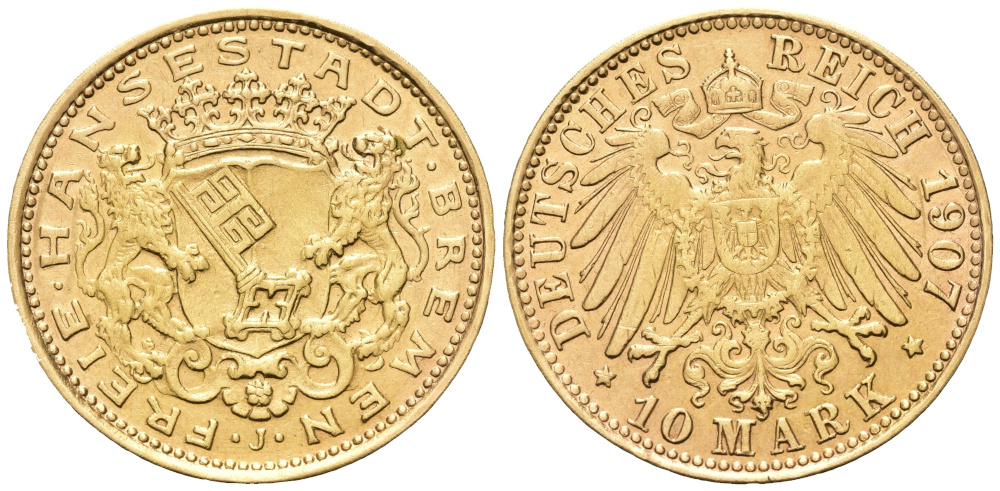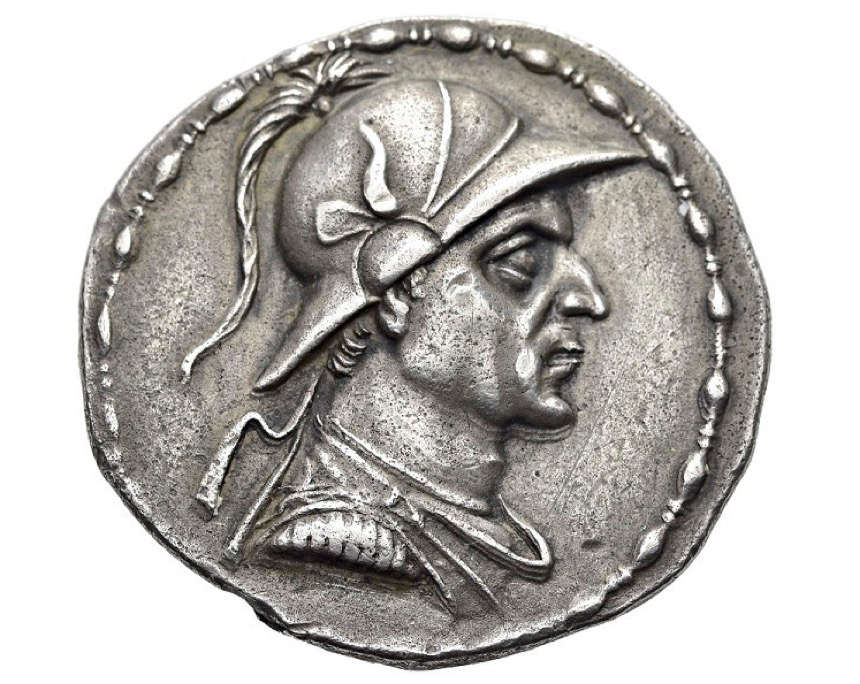Gorny & Mosch Auctions in October: The Klaus Grigo Collection
Gorny & Mosch,
Auctions 297-298
Coins
9-11 October 2023
D-Munich
From 9 to 11 October 2023, auction 297 part 1 with the “Collection Klaus Grigo”, auction 297 part 2 with “Coins of Antiquity” and auction 298 with “Selected Coins and Medals from the Middle Ages until the Modern Period” will be held by the Munich auction house Gorny & Mosch. Three printed catalogs complement the sales.
The offer of auctions 297 and 298 at a glance:
- Celts – Lot 1001-1020
- Greeks – Lot 1021-1374
- Roman Provincial Coinage – Lot 1375-1390
- Roman Republic – Lot 1391-1463
- Roman Imperial Period – Lot 1464-1572
- Byzantium – Lot 1573-1611
- Migration Period – Lot 1612-1613
- Migration Period – Lot 2001
- Medieval Europe – Lot 2002-2050
- German coins and medals up to 1871 – Lot 2051-2346
- Germany after 1871 – Lot 2347-2529
- Medals – Lot 2530-2541
- Austria-Hungary – Lot 2542-2567
- European coins and medals – Lot 2568-2689
- World coins – Lot 2699-2745
- Islamic coinage – Lot 2746-2745
Collection Klaus Grigo – Kingdom of Bactria and Tributary Territories
Kicking off the fall auctions of Gorny & Mosch in Munich, the Bochum collection of Klaus Grigo will be on sale. More than 530 coins from the Kingdom of Bactria and tributary territories will be offered in a separate auction on 9 October starting at 2 p.m. Klaus Grigo, who was already enthusiastic about numismatics as a schoolboy, assembled the collection for more than 30 years. His numismatic mentor was Osmund Bopearachchi, the author of the reference work “Monnaies gréco-bactriennes et indo-grecques” (1991), who also helped him to build up this collection. Something special about the sale is that, for the first time, the complete collection will be published in a paperback catalog and auctioned off as a whole. The catalog includes a detailed biography of the collector.

© Gorny & Mosch Giessener Münzhandlung GmbH Auction 297 Part 1, 2023, 152 (image: Gorny & Mosch, Munich).
- Lot No. 152: Kingdom of Bactria. Euthydemus I, ca. 225 – 200 BC. Stater ø 19mm (8.25g), ca. 225 BC. Very rare, Bordeaux only lists 11 specimens of the series A staters! Gold! Rev. minor double strike, FDC. Estimate: 15,000 euros.
Euthydemus I was among the most important Greco-Bactrian kings. He came to power by overthrowing Diodotus II around 225 BC. In 208/06 BC, he fought off the invasion of Antiochus III: a peace treaty put an end to the hostilities, with the Seleucid recognizing the Kingdom of Euthydemus. This gold stater, whose obverse strongly resembles the portrait of Diodotus I, is one of the earliest coins issued by Euthydemus; it was probably even minted during the civil war with Diodotus II. The depiction on the reverse might resemble the home town of Euthydemus, who was from Magnesia according to Polybius; after all, tetradrachms with a similarly designed Heracles sitting on a rock were minted in Magnesia ad Sipylum under Antiochus I (SC 318).
- Lot No. 199: Kingdom of Bactria. Agathokles Dikaios, ca. 185 – 178 BC. Tetradrachm ø 32mm (16.19g). Very rare, Glenn only lists 10 specimens of this type! Very fine to extremely fine. Estimate: 15,000 euros.
This one and the following lots are commemorative coins by Agathokles, whose obverse and reverse designs recall almost all kings that ruled Bactria before him: the series includes Alexander the Great, Antiochus II, Diodotus I and II, Euthydemus I, Demetrius I and Pantaleon. The ruler who commissioned the coins is only mentioned in the legend on the reverse. Agathokles probably minted these commemorative pieces because he was under pressure to legitimize his rule: since he probably was neither related to the Diodotid nor the Euthydemid dynasties, he wanted to portray himself as a legitimate ruler by honoring the old kings.
Among the rarest commemorative coins are those issued in honor of Alexander the Great: this tetradrachm is only the fourth specimen that has come onto the market in the last two decades (see Roma Auction XX, 2020, No. 344).

© Gorny & Mosch Giessener Münzhandlung GmbH Auction 297 Part 1, 2023, 329 (image: Gorny & Mosch, Munich).
- Lot No. 329: Kingdom of Bactria. Antialcidas Nikephoros, ca. 120 – 100 BC. Tetradrachm, minted according to the Attic standard ø 33mm (16.47g). Very rare, the third known specimen! Beautiful toning. Rev. traces of corrosion, very fine to extremely fine. Estimate: 10,000 euros.
Antialcidas is the only successor of Menander I to whom we can attribute an inscription with certainty: it was engraved onto a stone column that can still be admired in situ at Vidisa (north of Sanchi). The text is written in Brahmi and was discovered in 1909 by John H. Marshall. It explains that the column was erected by Heliodorus, son of Dion, in honor of the Hindu god Vasudeva. Heliodorus was travelling as an envoy of Antialcidas in order to visit the Indian King Kasiputra Bhagabhadra (ca. 114 – 82 BC) during the 14th year of his reign. This makes Antialcidas the only Indo-Greek king whose diplomatic contacts to the Shunga dynasty are proven by historical sources. Antialcidas emphasized the importance of his kingdom by issuing Attic tetradrachms following the model of Greco-Bactrian monarchs, whose empire had perished about a decade before he ascended the throne. On the obverse of this series, he stylized himself as the successor of Eucratides I by adopting his helmet that is adorned with bull horns and ears. Three specimens are known of the variety on offer, whose entire reverse legend is displayed in an arched form. One of them is kept at the Cabinet des Médailles (R.3681.190).
- Lot No. 378: Kingdom of Bactria. Straton I Epiphanes Dikaios Soter, ca. 110 – 95 BC. Tetradrachm, minted according to the Indian standard ø 29mm (9.76g). Very rare! Extremely fine to FDC. Estimate: 10,000 euros.
With the expressive obverse design, Straton I underlined his claim of being the legitimate successor of Menander I, who also often had himself depicted on his coins as a heroic spear carrier with aegis.
Auction 297 Part 2
More than 600 ancient coins will be offered on the following day, 10 October 2023, by the Munich auction house Gorny & Mosch at its business premises. The offer a collection of Greek coins with emphasis on Magna Graecia as well as a collection of Roman Republic, Roman Empire and Byzantium
- Lot No. 1036: Akragas. Tetradrachm ø 26mm (16.66g), approx. 409 – 406 BC. Very rare! With signature of the engraver Straton. Slight toning, minor cleaning scratch, extremely fine. Estimate: 15,000 euros.

© Gorny & Mosch Giessener Münzhandlung GmbH Auction 297 Part 2, 2023, 1224 (image: Gorny & Mosch, Munich).
- Lot No. 1224: Bosporan Kingdom. Spartokos V, ca. 200 – 180 BC. Didrachm ø 23mm (8.37g). Extremely rare! Slight toning, minor cleaning traces with remnants of horn silver in recessed areas. Rev. traces of an overstrike with remnants of the circumscription of the former strike at the edge, very fine. Estimate: 20,000 euros.
Although the Spartocid dynasty ruled the Kingdom of Bosporus from approx. 438 – 108 BC, little is known about these rulers. The dynasty was founded by Spartokos I, who was probably an Odrysian mercenary that usurped the rule from the Archaeanactids. Apparently, there were five rulers named Spartokos, and this coin is attributed to the last of them. Only a few specimens have been published. For a long time, the only known specimen was that of the State Historical Museum in Moscow (SHM 14153), which is of very poor quality and was described for the first time as early as in 1821. Another specimen was found in the 1980s and is now part of the collection of the American Numismatic Society. In 2007, V. N. Rosov published a third specimen. There are more or less precise reports of other found specimens. Nina Frolova commented on these coins in 2013 (see below). A crucial difference between the Moscow piece and, as far as known, all other didrachms, is the design of the epsilon in the king’s title. Regarding the first coin, it is semicircular, a feature that emerged in the advanced Hellenistic period, while the epsilon on the other pieces are angular. Frolova considers all pieces except the one at the Historical Museum in the Red Square to be counterfeits. The piece on offer also has an angular epsilon but has merely any similarities to the piece at the ANS and that published by Rozov in terms of style. It seems to rather resemble the Moscow specimen, but was made from other dies. The portrait’s resemblance to those of Mithridates VI is striking, with the ruler’s wild hair reinforcing the message that Alexander had conveyed with his ideal image of a dynamic, youthful ruler. The portrait of Spartokos is an interesting intermediary step in this development. This coin probably depicts the best portrait of this ruler that still exists today. Summarizing and with older literature N. A. Frolova, Catalogue of Coins of the Kings of the Spartocid Dynasty in the 2nd century B.C, in: Ancient Civilisations from Scythia to Siberia 19, 2013, p. 217-276; esp. p. 234 ff.; 261 ff. The best image of the Moscow specimen in O. N. Melnikov, K numismatike Bospora Kimmeriyskogo etapa srednego ellinisma, Sugdejskij Sbornik, Kiev – Sudak, 2010, IV, p. 137-165.
- Lot No. 1318: Seleucids. Seleucus I Nicator, 312 – 281 BC. Tetradrachm ø 25mm (17.14g), approx. 305/4 – 295 BC. Extremely fine to FDC. Estimate: 15,000 euros.
- Lot No. 1490: Roman Empire. Domitian as Caesar, 69 – 81 AD. Aureus ø 19mm (7.28g). 77 – 78 AD. Rare! Gold! Extremely fine. Estimate: 15,000 euros.
Auction 298
The sale of modern issues on 11 October 2023 includes more than 740 coins and medals, especially from the Middle Ages, the German States, the German Empire, the Weimar Republic, medals, Judaica, Habsburg, Europe, especially Italy, Russia and overseas.
- Lot No. 2266: German Coins and Medals up to 1871. Saxony, Electors and Albertine line. John George II, 1656 – 1680. 5 ducats 1657, Dresden. Extremely rare. Gold! Magnificent gold toning, minor weak strike, fields slightly worked, extremely fine. Estimate: 40,000 euros.
- Lot No. 2305: German Coins and Medals up to 1871. Silesia – Legnica – Brzeg. John Christian and George Rudolf, 1602 – 1621. 3 ducats 1610 CT, Reichenstein. Coinage administrator Christoph Tuchmann. Very rare! Showpiece. Gold! Fine gold toning, miniscule scratches, about FDC. Estimate: 20,000 euros.
- Lot No. 2648: European Coins and Medals. Poland. At the time of Sigismund III, 1587 – 1632. Gulden of 2/3 reichstalers n.d. (probably 1613 – 1632, most likely 1618). Extremely rare! The only known specimen market. Irregular toning, very fine. Estimate: 65,000 euros.
e-auction 299
On 7 November 2023 starting at 10 a.m., coins, medals and multiple lots from antiquity to modern times will be auctioned off online. They include coins from ancient times as well as multiple lots, medieval Germany, a wide range of pieces from the German States, Germany after 1871 including many German Empire, Habsburg, European and world issues.
Viewing
The viewing takes place at Gorny & Mosch, Maximiliansplatz now: Monday – Friday, 10 a.m. – 1 p.m. and 2:30 p.m. – 6 p.m. or after prior appointment.
The catalogs for auctions 297 part 1, 297 part 2 and 298 can be ordered from Gorny & Mosch, Giessener Münzhandlung, Maximiliansplatz 20, 80333 Munich, Germany, phone: +49 (0)89 24 22 643-0, fax: +49 (0)89 22 85 513.

















